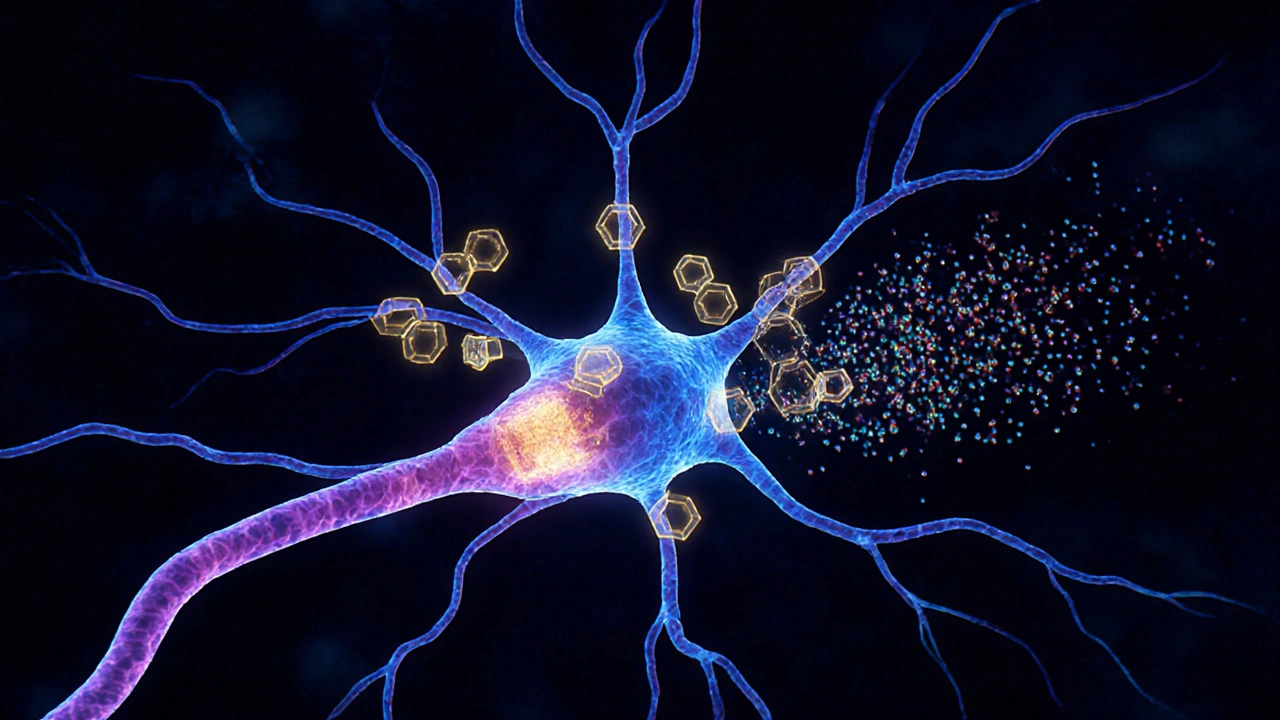Gabapentin (Neurontin) vs. Common Alternatives - Which Is Right for You?

Gabapentin Alternative Selector
Your Condition
Key Concerns
Recommended Alternatives
Pregabalin (Lyrica)
Faster onset, lower dizziness risk
Carbamazepine (Tegretol)
Gold standard for trigeminal neuralgia
Amitriptyline (Elavil)
Dual mood and pain relief
Personalized Recommendation
Select a condition and key concerns to see personalized recommendations.
Quick Summary
- Gabapentin (Neurontin) is a first‑line seizure and nerve‑pain drug but isn’t always the best fit.
- Pregabalin, carbamazepine, amitriptyline, duloxetine, baclofen, lamotrigine and valproic acid cover most therapeutic gaps.
- Switching requires a taper, monitoring for withdrawal, and a clear plan with your prescriber.
- Cost, side‑effect profile, and the condition you’re treating are the top decision factors.
- Use the comparison table below to match your needs with the most suitable alternative.
When a doctor prescribes Gabapentin - sold under the brand name Neurontin - most patients think it’s a one‑size‑fits‑all solution for seizures, post‑herpetic neuralgia, or fibromyalgia. In reality, the drug’s chemistry, dosing quirks, and side‑effects make it a good choice for some patients and a poor fit for others. That’s why many turn to alternatives that hit the same nerve‑pain pathways but with a different safety or efficacy balance.
Below you’ll find a thorough, side‑by‑side look at the most commonly considered substitutes. The aim is simple: help you understand when gabapentin works, when it doesn’t, and which option is likely to give you the relief you need without unnecessary hassle.
How Gabapentin Works (and When It Falls Short)
Gabapentin is a structural analogue of the neurotransmitter GABA, but it doesn’t bind to GABA receptors. Instead, it latches onto the α2δ subunit of voltage‑gated calcium channels, dampening excitatory neurotransmitter release. This mechanism reduces the “over‑firing” that causes seizures and nerve‑pain signals.
Typical uses in 2025 include:
- Partial seizures (as adjunct therapy)
- Post‑herpetic neuralgia
- Diabetic peripheral neuropathy
- Restless‑leg syndrome
- Fibromyalgia (off‑label)
The drug is well‑absorbed orally, but bioavailability drops from ~60% at 300mg to ~35% at 1,800mg, making high‑dose regimens less predictable. Common side effects-dizziness, somnolence, peripheral edema, and mild weight gain-can be troublesome, especially for older adults. Moreover, abrupt discontinuation can trigger withdrawal symptoms such as anxiety, insomnia, and even seizures.
When to Look for an Alternative
If you’ve experienced any of the following, it’s time to discuss a switch with your prescriber:
- Persistent dizziness that interferes with work or driving.
- Significant weight gain (>10lb) after a few months of therapy.
- Insufficient pain relief after 6-8weeks at a therapeutic dose.
- Drug‑interaction concerns (e.g., concurrent use of antacids that reduce gabapentin absorption).
- Cost spikes due to generic shortage or insurance formulary changes.
In each case, an alternative may offer a cleaner side‑effect profile, a more predictable dosing schedule, or better insurance coverage.

Side‑by‑Side Comparison of Popular Alternatives
| Brand / Generic | FDA Approval Year | Typical Uses | Usual Dose Range | Common Side Effects | Average Monthly Cost (US$) | Onset of Pain Relief |
|---|---|---|---|---|---|---|
| Neurontin (Gabapentin) | 1993 | Seizures, post‑herpetic neuralgia, diabetic neuropathy, restless‑leg syndrome | 300mg - 3,600mg/day | Dizziness, somnolence, edema, weight gain | ~$30 (generic) | 1-2weeks |
| Lyrica (Pregabalin) | 2004 | Neuropathic pain, fibromyalgia, generalized anxiety disorder, epilepsy adjunct | 150mg - 600mg/day | Dizziness, dry mouth, blurred vision, weight gain | ~$90 (brand) / $35 (generic) | 3-7days |
| Tegretol (Carbamazepine) | 1968 | Partial seizures, trigeminal neuralgia, bipolar disorder | 200mg - 1,200mg/day | Nausea, drowsiness, rash, hyponatremia | ~$20 | 1-2weeks |
| Elavil (Amitriptyline) | 1961 | Depression, neuropathic pain, migraine prophylaxis | 10mg - 150mg/day | Dry mouth, constipation, weight gain, sedation | ~$12 | 2-4weeks |
| Cymbalta (Duloxetine) | 2004 | Major depressive disorder, generalized anxiety, diabetic neuropathy, chronic musculoskeletal pain | 30mg - 120mg/day | Nausea, insomnia, dry mouth, increased blood pressure | ~$45 | 1-2weeks |
| Lioresal (Baclofen) | 1978 | Spasticity, muscle relaxant, off‑label neuropathic pain | 5mg - 80mg/day | Drowsiness, weakness, dizziness, nausea | ~$15 | 3-5days |
| Lamictal (Lamotrigine) | 1994 | Partial seizures, bipolar depression | 25mg - 400mg/day | Rash (rare severe), dizziness, headache | ~$25 | 2-4weeks |
| Depakote (Valproic acid) | 1978 | Generalized seizures, migraine prophylaxis, bipolar disorder | 250mg - 2,000mg/day | Weight gain, tremor, liver enzymes elevation | ~$30 | 1-2weeks |
Choosing the Right Alternative for Your Situation
Below is a quick guide that matches common clinical scenarios with the drug that tends to work best. Think of it as a decision tree you can discuss with your prescriber.
- Neuropathic pain (diabetic or post‑herpetic) with dizziness as a deal‑breaker: Pregabalin (Lyrica) often provides faster relief and has a lower dose‑dependent dizziness profile.
- Trigeminal neuralgia or severe facial pain: Carbamazepine (Tegretol) is the gold standard because it directly blocks sodium channels involved in that pain pathway.
- Co‑existing depression or insomnia: Amitriptyline (Elavil) hits both mood and pain, but watch out for anticholinergic side effects in older adults.
- Combined anxiety and nerve pain: Duloxetine (Cymbalta) offers dual action on serotonin and norepinephrine reuptake, which can improve both mood and pain.
- Spasticity with mild neuropathic component: Baclofen (Lioresal) relaxes muscle tone and may reduce accompanying pain.
- History of liver disease: Avoid Valproic acid (Depakote) and choose a drug with minimal hepatic metabolism such as Pregabalin.
- Pregnancy considerations: Gabapentin and Pregabalin are Category C; Lamotrigine is often preferred for seizure control in pregnancy due to better safety data.
How to Switch Safely from Gabapentin to an Alternative
Never stop gabapentin abruptly. A taper reduces the risk of rebound seizures and withdrawal symptoms. Here’s a practical three‑step plan you can adapt:
- Discuss a taper schedule with your prescriber. A typical reduction is 300mg every 3-4days for low‑dose patients, or 600mg every 5-7days for higher doses.
- Start the new medication at a low dose. For example, if moving to pregabalin, begin with 75mg once daily and increase every 3-4days as tolerated.
- Monitor symptoms closely. Keep a daily log of pain scores, sleep quality, and any side effects. Call your doctor if seizures recur or if pain spikes dramatically.
Most patients report a smoother transition when the new drug’s half‑life is shorter (like pregabalin) because it reaches steady state quickly.

Cost and Insurance Tips
Drug pricing in 2025 still varies widely by pharmacy and plan. A few tricks to keep your out‑of‑pocket cost down:
- Ask for the generic version (e.g., generic pregabalin) - it’s usually 30‑50% cheaper than brand.
- Check if your plan’s formulary prefers a specific alternative; switching to that can shave off co‑pays.
- Use reputable online pharmacies that offer a 30‑day supply discount for chronic prescriptions. li>Consider a 90‑day supply if you have stable dosing; many insurers waive the first‑fill co‑pay.
Potential Pitfalls and How to Avoid Them
Switching medications isn’t without risk. Keep an eye out for these common mistakes:
- Overlapping high doses. Taking full gabapentin doses while titrating up a new drug can cause excessive sedation.
- Ignoring drug-drug interactions. For instance, carbamazepine induces CYP3A4 and can lower levels of oral contraceptives.
- Not accounting for renal function. Both gabapentin and pregabalin are renally cleared; dose‑adjust in CKD stages 3‑5. li>Missing the “onset window.” Some drugs (like amitriptyline) need several weeks to show pain relief; switching too quickly may lead to unnecessary disappointment.
Real‑World Stories (What Patients Say)
Maria, 58, diabetic neuropathy: “I tried gabapentin for three months, but the dizziness made it impossible to work. My doctor switched me to pregabalin, and within a week the pain eased and the fog lifted.”
James, 34, trigeminal neuralgia: “Carbamazepine gave me instant relief, but I developed a rash after a month. Switching to lamotrigine under specialist care kept the pain at bay without skin issues.”
These anecdotes reinforce the idea that the “best” drug really depends on personal tolerance, underlying conditions, and cost constraints.
Frequently Asked Questions
Can I take gabapentin and pregabalin together?
Generally no. Both drugs act on the same calcium‑channel subunit, so combining them rarely adds benefit and often heightens side effects like drowsiness and edema. Only a neurologist might prescribe them together in rare, refractory cases.
Is gabapentin safe during pregnancy?
Gabapentin is classified as Category C, meaning risk cannot be ruled out. If seizure control is essential, doctors may continue it but will monitor the fetus closely. Alternatives like lamotrigine have more robust safety data for pregnancy.
Why does gabapentin cause weight gain?
The exact mechanism isn’t fully understood, but gabapentin can increase appetite and cause fluid retention. Switching to a drug with a lower metabolic impact, such as pregabalin, often stabilizes weight.
How long does it take for baclofen to help neuropathic pain?
Baclofen’s muscle‑relaxant effect can be felt within a few days, but its influence on nerve‑pain may require 1-2weeks of consistent dosing.
What should I do if I experience a rash on carbamazepine?
Stop the medication immediately and contact your healthcare provider. Carbamazepine can cause Stevens‑Johnson syndrome, a serious skin reaction. An alternative like lamotrigine (with slower titration) is often recommended.
Choosing an alternative to gabapentin isn’t a one‑size‑fits‑all decision. By weighing efficacy, side‑effects, cost, and personal health factors, you can land on the medication that matches your life the best. Talk openly with your prescriber, follow a careful taper, and keep track of how you feel-you’ll be in control of your pain management journey.





Joshua Brown
October 10, 2025 AT 22:21Gabapentin remains a cornerstone for neuropathic pain, yet its pharmacokinetic quirks demand careful consideration; the drug’s bioavailability drops dramatically as the dose climbs, which can leave patients on high regimens chasing inconsistent plasma levels; this variability often translates into unpredictable side‑effect profiles, especially dizziness and somnolence, that can jeopardize work safety; in contrast, pregabalin offers a more linear absorption curve, making titration smoother and side‑effects marginally lower for many; carbamazepine, while venerable for trigeminal neuralgia, bears the burden of CYP3A4 induction, necessitating vigilant monitoring of co‑medications; the risk of hyponatremia with carbamazepine also mandates periodic electrolyte checks, particularly in elderly patients; amitriptyline, the low‑cost tricyclic, provides dual mood‑pain relief, yet its anticholinergic load can exacerbate constipation and cognitive fog, a trade‑off that must be weighed against its affordability; duloxetine’s serotonin‑norepinephrine reuptake inhibition shines in patients with comorbid depression, but its potential to raise blood pressure calls for baseline and follow‑up readings; baclofen excels in spasticity‑related pain, though its muscle‑weakening effect may limit ambulation in active individuals; lamotrigine’s minimal weight gain and rash‑monitoring protocol make it attractive for women of child‑bearing age, albeit with a slower onset for seizure control; valproic acid remains a broad‑spectrum option, yet its hepatotoxicity risk restricts use in patients with liver disease; when cost is paramount, generic gabapentin and carbamazepine often undercut newer agents, but insurance formularies can flip the economics in favor of pregabalin or duloxetine; a prudent taper from gabapentin-300 mg reductions every three to four days-smooths withdrawal, and overlapping the new agent at a low dose prevents breakthrough pain; clinicians should match the drug’s side‑effect fingerprint to the patient’s comorbidities, lifestyle, and financial constraints; ultimately, shared decision‑making, informed by these pharmacologic nuances, empowers patients to land on the therapy that aligns with their health goals.
andrew bigdick
October 15, 2025 AT 15:41Looking at the table, it’s clear that each alternative brings its own sweet spot-pregabalin for fast pain relief, carbamazepine for that classic facial nerve pain, and amitriptyline when mood needs a lift too. The cost column can be a game‑changer, especially if your insurance nudges you toward generics. If dizziness is your nemesis, pregabalin’s lower dose‑dependent vertigo might be a win. And remember, tapering gabapentin isn’t just a checkbox; it smooths the transition and keeps seizures at bay.
Henry Kim
October 20, 2025 AT 09:01Switching can feel daunting, but a slow gabapentin taper plus a low‑start of the new drug usually works well.
Neha Bharti
October 25, 2025 AT 02:21Each medication whispers a different philosophy of care; some prioritize speed, others safety. Choose the one that aligns with your daily rhythm, not just the headline efficacy.
Samantha Patrick
October 29, 2025 AT 19:41Yo, if u r lookin at the cost, gabapentin is pretty cheap but it can make u feel like a zombie. Pregablin on the other hand might be a lil pricier but it’s less likely to make u dizz.
Sophie Rabey
November 3, 2025 AT 13:01From a pharmacology standpoint, gabapentin’s “slow‑on‑set” can be a real buzzkill for patients who want immediate relief-think of it as waiting for the Wi‑Fi to load a 4K video. Pregabalin, by contrast, hits the bandwidth fast, but its price tag can feel like subscription‑service overload. Carbamazepine is the old‑school rockstar, but you gotta watch out for the skin‑rash drama. So, pick your fighter based on the side‑effect profile and the wallet‑impact, not just the hype.
Bruce Heintz
November 8, 2025 AT 06:21Totally get the frustration with dizziness 😅 – that’s why many of us end up switching to pregabalin, which tends to be a bit easier on the balance. Just remember to taper gabapentin slowly and you’ll be good! 👍
richard king
November 12, 2025 AT 23:41Imagine a battlefield where gabapentin is the weary veteran, its armor cracked by dose‑dependent dizziness, while pregabalin arrives on a sleek, silver steed-swift, decisive, and unburdened by the fog of somnolence. Yet, the seasoned carbamazepine, cloaked in decades of triumph over trigeminal fire, still commands respect, albeit with a hidden venom of hyponatremia that can strike the unsuspecting.
William Lawrence
November 17, 2025 AT 17:01Sure, gabapentin works for some but the side effects are a nightmare.
Grace Shaw
November 22, 2025 AT 10:21Dear Readers,
In the contemporary landscape of neuropathic pain management, one must engage in a meticulous appraisal of the pharmacotherapeutic armamentarium, weighing both efficacy and tolerability with the utmost rigor. Gabapentin, whilst venerable, is beset by a pharmacokinetic profile that may engender suboptimal plasma concentrations at higher dosages, thereby precipitating dose‑related adverse events such as vertigo and somnolence. Conversely, pregabalin demonstrates a more predictable absorption curve, affording clinicians the latitude to titrate with precision and patients the benefit of rapid analgesic onset.
Carbamazepine retains its pre‑eminence in the treatment of trigeminal neuralgia; however, its propensity to induce hyponatremia and interfere with cytochrome‑mediated metabolism necessitates vigilant laboratory surveillance, particularly in the geriatric cohort. Amitriptyline, as a cost‑effective alternative, affords dual antidepressant‑analgesic properties, yet its anticholinergic burden may be deleterious in individuals predisposed to constipation or cognitive impairment.
In sum, the judicious selection of an alternative to gabapentin mandates an individualized approach, cognizant of comorbidities, financial constraints, and patient preference. I implore you to engage in a collaborative dialogue with your prescriber, ensuring that the chosen therapeutic pathway aligns harmoniously with your clinical objectives.
Sean Powell
November 27, 2025 AT 03:41Yo bro, carbamazepine is classic but watch ur liver, pregablin is hot & cheap? check ur plan.
Henry Clay
December 1, 2025 AT 21:01Gabapentin is over‑prescribed, side effects are real 😑; consider a switch if you cant tolerate.
Isha Khullar
December 6, 2025 AT 14:21When the weight gain from gabapentin feels like an invisible shackles, the drama of switching to pregabalin becomes not just a medical decision but an epic quest for bodily autonomy.
Lila Tyas
December 11, 2025 AT 07:41Hey folks! If you’re struggling with that foggy feeling on gabapentin, don’t lose hope-there’s a whole toolbox of alternatives waiting for you. Jump on a call with your doc, outline your concerns, and you might find pregabalin or even amitriptyline to be the fresh start you need. Keep moving forward!